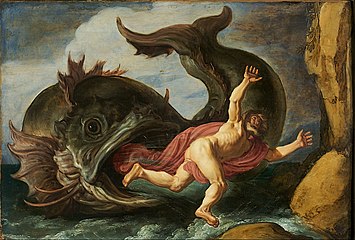
The Heptanese school of painting succeeded the Cretan school as the leading school of Greek post-Byzantine painting after Crete fell to the Ottomans in 1669. Like the Cretan school, it combined Byzantine traditions with an increasing Western European artistic influence and also saw the first significant depiction of secular subjects. The school was based in the Ionian Islands, which were not part of Ottoman Greece, from the middle of the 17th century until the middle of the 19th century. The center of Greek art migrated urgently to the Ionian Islands but countless Greek artists were influenced by the school including the ones living throughout the Greek communities in the Ottoman Empire and elsewhere in the world.
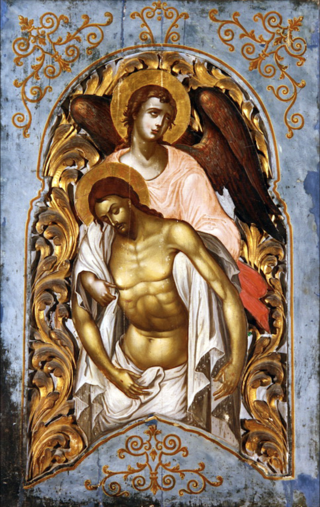
Nikolaos Kallergis, also known as Kalergis. He was a Greek painter during the Greek Rococo and the Modern Greek Enlightenment in art also known as Neo-Hellenikos Diafotismos. His art also exhibited Venetian influence. Painters of the maniera greca began to refine their art. Philotheos Skoufos, Elias Moskos, and Theodore Poulakis were all active painters on the Ionian Islands prior to Kallergis. They set the stage for the transition to the Heptanese School. Panagiotis Doxaras is the forefather of the new painting style. He was the father of Greek Rococo and the Modern Greek Enlightenment in painting. Kallergis became an active member of the school. Kallergis also represents the Greek Rococo. His art began to exhibit qualities of Greek and Italian Neoclassicism. His style influenced countless painters. Examples include Nikolaos Kantounis, Nikolaos Koutouzis, Nikolaos Doxaras, Spiridione Roma, and Eustathios Karousos. His most famous work is Christ and Angel it is at the Zakynthos Museum.

Spyridon Sperantzas was a Greek painter. He flourished during the Greek Neoclassical era and the Modern Greek Enlightenment in art also known as Neo-Hellenikos Diafotismos. Because of the Fall of the Republic of Venice, Sperantzas brought the Heptanese School into the Greek Romantic period. By the 1800s the Ionian Islands were occupied by both French and English forces and for the first time since the fall of the Byzantine Empire, the local Greeks governed themselves. Sperantzas, Nikolaos Kantounis, and Nikolaos Koutouzis represent the transition in painting that defined Modern Greek art. Sperantzas was influenced by Nikolaos Kallergis, Nikolaos Doxaras, and Nikolaos Koutouzis. His son Michael Sperantzas was also a famous painter and his apprentice. Spyridon also painted frescos.
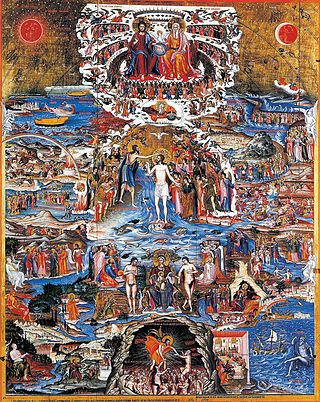
Ioannis Kornaros was a Greek painter. He was one of the few painters from Crete during the 19th century. He does not belong to the Cretan Renaissance but was influenced by the art. He is considered to be one of the foremost icon painters of the Greek Neoclassical era and Modern Greek Enlightenment in art also known as Neo Hellenikos Diafotismos. He implemented a unique style. He was influenced by Michael Damaskinos, Georgios Klontzas, Victor and other Cretan artists. He influenced Modern Greek art. He is one few Greek painters affiliated with Cyprus. Others included Ioannis Kyprios and Theodore Apsevdis. His teacher was Georgios Kastrofylakas. His most famous painting Great Art Thou resembles Georgios Klontzas's In Thee Rejoiceth.

Stylianos Stavrakis, was a Greek painter during the Neo-Hellenic Enlightenment era in art. He was a goldsmith and painter. He was very active on the Ionian Islands. Nikolaos Koutouzis, Nikolaos Doxaras and Nikolaos Kallergis were all active in Zakynthos during the same period. He is a prominent member of the coveted Heptanese painting style. He comes from a family of painters. His brother Andreas Stavrakis and nephew Demetrios Stavrakis were both famous painters. He influenced countless artists. Konstantinos Kontarinis and other artists of the Ionian Islands began to emulate his work. His most notable work is The Deposition from the Cross (Stavrakis). Fourteen of his paintings survived. Most of them can be found in Zakynthos, Greece.

Ioanni Korai was a Greek painter that shared the same name as his famous uncle Ioannis Korais. He was a prominent painter on the Ionian Islands. His family migrated to Zakynthos from Chios. He was a member of the Heptanese School. His contemporaries were Dionysios Kallivokas and Nikolaos Koutouzis. He was taught painting by Ioannis Korais. He was active during the Modern Greek Enlightenment and Greek romanticism in art. He influenced countless Greek and Italian painters. Korai brought Greek artwork into the Modern Greek art period. Twelve of his paintings survived. His most notable painting is a portrait of Kyriakos Chorafas painted in 1826. The painting is at the National Gallery of Athens.

Stylianos Devaris, also known as Defaris and Kornaros respectively. He was a Greek painter and goldsmith. He was one of the prominent painters from the island of Lefkada. He was a member of the Heptanese School. The island featured many painters namely: Konstantinos Kontarinis, Spyridon Ventouras, Spyridon Maratzos, and Makarios Lefkas. A notable theme popular on the island was John Chrysostom, Criticizing Empress Eudoxia. Stylianos painted his own version of the theme. Spyridon Ventouras and Makarios Lefkas also painted their versions. Devaris mainly painted ecclesiastical themes. According to the Institute of Neohellenic Research, over nineteen of his paintings have survived. His most notable work was John Chrysostom, Criticizing Empress Eudoxia.
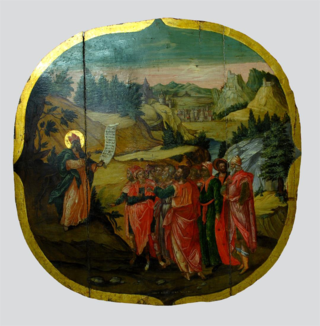
Demetrios Nomikos was a Greek painter, goldsmith, and priest. He shared the same last name with other famous Greek painters. Georgios Nomikos, Demetrios Nomikos and his brother Nicholas Nomikos. He is one of the early representatives of the Heptanese School of painting. He was active during the Greek Baroque and Rococo. He worked with notable Greek painter Antonios Notaras. Konstantinos Kontarinis, Stylianos Stavrakis and Nikolaos Kallergis were active on the same islands around the same period. Nomikos was a master gilder. According to the Institute of Neohellenic Research, five of his works survived. His most notable works are at the Loverdos Museum.

Demetrios Stavrakis, also known as the so-called Romanos was a Greek painter of the Heptanese School. His uncles were famous painters Andreas Stavrakis and Stylianos Stavrakis, active on the island of Zakynthos. Demetrios influenced both Greek and Italian artists. According to the Institute of Neohellenic Research, fifteen of his works survived. His most notable work was The Profit Jonah.
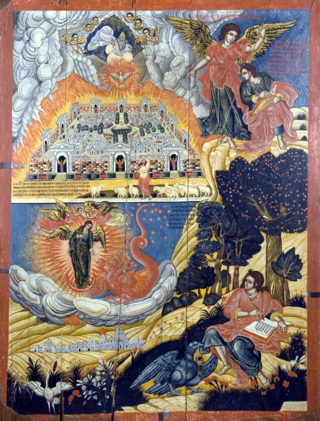
Michael Prevelis. He was a Greek painter. He was active on the island of Crete during the eighteenth century. He was one of few Greek painters still active on the island. Other painters included: Ioannis Kornaros and Georgios Kastrofylakas. His work diverged from the traditional Greek mannerism. He was a representative of the Neo-Hellenikos Diafotismos in art, he was another representative of the Greek Rococo and Baroque periods. The Greek mannerisms were reflected in iconography and other painted mediums at the time. Nine of his works have survived they are all located at the Preveli Monastery. His most notable work is the Book of Revelation.

Mary Magdalene is a tempera painting by Konstantinos Tzanes. Tzanes was a Greek painter active during the late Cretan Renaissance. Tzanes and his brothers migrated from Crete to Venice. His brother was famous painter Emmanuel Tzanes. They were both active during the 17th century. Twenty-one of his paintings survived. Both brothers uniquely contributed to the maniera greca. They made drastic improvements to the style redefining space and color. Their work is comparable to Michael Damaskinos.

Noah's Ark is a tempera painting by Theodore Poulakis. Poulakis was a Greek Baroque painter and teacher. He was a member of both the Late Cretan School and the Heptanese School. He is often regarded as the father of the Heptanese School. He was active from 1635 to 1692. By the age of 24, he was living in Venice. He stayed in the city for thirteen years. He was involved in local politics. He frequently traveled all over the Ionian Islands and settled in Corfu. He also regularly returned to Venice. Over 130 of his paintings have survived and can be found all over the world.

The Deposition from the Cross or Descent from the Cross is a tempera painting created by Greek painter Stylianos Stavrakis. He was active during the early part of the 1700s. His nephew and brother were also famous painters. His nephew Demetrios Stavrakis was also his pupil. He was also a goldsmith. Most of his works were completed on the island of Zakynthos. He was a representative of the Heptanese school and Greek Rococo. Fourteen of his paintings survived.

Vision of Constantine (Stavarkis) is a tempera painting created by Greek painter and goldsmith Stylianos Stavrakis. Stavrakis was a major representative of the Heptanese school. Many of his works were completed on the Ionian islands namely Zakynthos. He was active during the 1700s. He was from a prominent family of painters His student was his nephew famous Greek painter Demetrios Stavrakis.

Jacob’s Ladder is a tempera painting created by Elias Moskos. Elias was a Greek painter originally from the island of Crete. By the 1650s he was living on the island of Zakynthos. He also worked on the island of Kefalonia. There were two other painters active during his lifetime with the same last name. Ioannis Moskos and Leos Moskos. The painter was also a prominent teacher. He also had a sizable fortune. Fifty-two of his paintings survived. He represented the Cretan School and the Heptanese School. His works typically combine both schools. His work was heavily influenced by engravings from all over the world some were Flemish. His artistic activity ranged from 1629 to 1687. Most of his remaining works are in Greece and Italy.

The Holy Family is an oil painting created by Greek painter Panagiotis Doxaras. He was a prominent member of the Heptanese School. He was also an author. His son Nikolaos Doxaras was also a famous painter. Panayiotis was from a small village named Koutifari, close to Kalamata. He moved to Zakynthos at a young age. He studied painting with famous painter Leos Moskos. He traveled all over the Venetian empire with the famous artist including Venice. He studied painting in Venice for five years. He became a theoretical painter. He wrote several books on painting. He traveled all over the Ionian Islands. He lived in Lefkada, Zakynthos, and Corfu. He frescoed the ceiling of Panagia Faniromeni in Zakynthos. Eighteen of his paintings survived.

Angel Holding the Body of Christ was a work of art created by Greek painter Nikolaos Kallergis. Kallergis was born in Zakynthos. His family was originally from Crete. His father was a painter. Nikolaos was active from 1715–1747. He was a representative of the Heptanese School. His family owned a church on the island of Zakynthos and a massive library. The family was educated. According to the Institute of Neohellenic Research, thirty-two of his painting’s survived.

Saint Spyridon, John the Baptist, Saint Peter and Saint George is an oil painting created by Greek painter Nikolaos Koutouzis. He was a prominent member of the Heptanese School of painting. He was from the island of Zakynthos. He studied with Nikolaos Doxaras and Giovanni Tiepolo. He was an active painter for over fifty years. One hundred and thirty-six paintings are attributed to the artist. He was active from 1750 to 1813.

The Holy Trinity is a tempera painting created by Spyridon Romas. He was a Greek painter from Corfu. He was a prominent member of the Heptanese School. He was active from 1745 to 1786. He traveled all over the world. He painted in Corfu, Lecce, Livorno, and London. According to the Hellenic Institute over 25 of his works survived. He is one of the few Greek painters to completely adopt a new style of painting. He traveled to London, England around 1770 and remained in the country until his death. He painted several portraits but also maintained artwork in the region. An iconostasis with most of his works is superlatively preserved in Livorno, Italy at the Museo della Città di Livorno.

The Virgin and Child Enthroned is a tempera painting created by Spyridon Romas. He was a Greek painter from the island of Corfu and a prominent member of the Heptanese School active from 1745 to 1786 in Corfu, Lecce, Livorno, and London. Twenty-five of his works survived according to research completed by the Hellenic Institute. One of few Greek painters that changed his style completely Romas transitioned from the Heptanese School to the British style of painting. He traveled to London, England around 1770, and remained in the country until his death. Romas painted several portraits but also maintained art. An important iconostasis containing most of his works is preserved in Livorno, Italy at the Museo della Città di Livorno.



